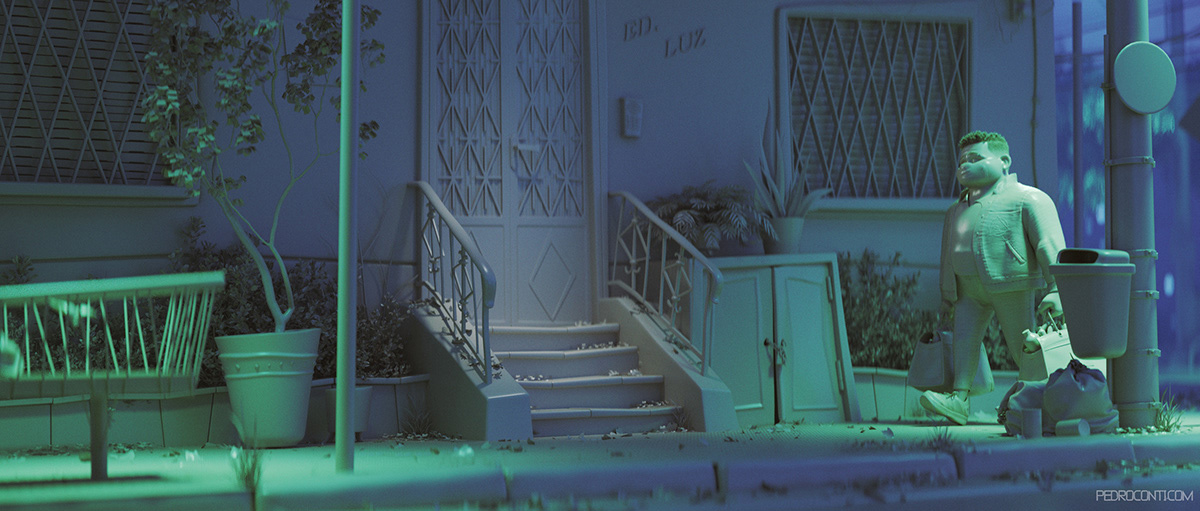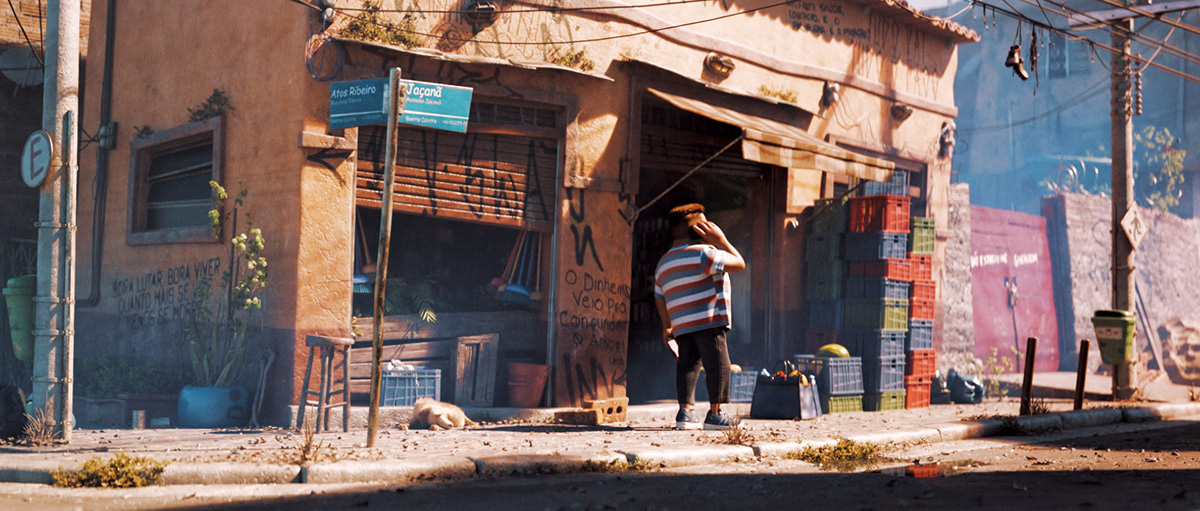TAMO JUNTO
By Fydell Botti and Pedro Conti
The technology is bizarre. I was very impressed to see that nothing is impossible in animation. Placing the camera 15 meters high is the simplest task. Getting it closer to the character using the Dolly In move along with a Boom move, from the bottom up, is the easiest thing in the world. I don’t need a lot of heavy machinery for that.







LENS SIMULATION
AND LIGHTING
Simulating lens texture is a really cool thing. In this case, it is very similar to Live Action. You define the glass you want to use and the plugins that simulate it. If in one scene or another you find that you should change the focal length and change the depth of field, that also happens. In this case, it’s almost similar, but you just don’t have a set of lenses and a limited range of focal lengths. The sky is the limit! In general, we can simulate any type of lens, including anamorphic lenses, as in the case of “Tamo Junto”.
When using the tools used for lighting, you have control of position, height, intensity, nature, temperature, all at your fingertips. There are very interesting things when you light up a scene in animation. If you want an ultra bounce nature with a bounce on a 6×6 Butterfly like in Live Action, you don’t need the light head, the Butterfly with the specific cloth to have something similar. All this is in a single spot, you have control over it with no spot size limit. You can easily direct it, put the height you want. If you need to do all this in a very open plan, you can make the light spots invisible with one click.
The 3D camera works like a physical camera, we have F-stop control, shutter speed, white balance and more. The only difference is the scale we work with, a little smaller than the real scale. We were able to have a little more light bounce.
RED LIGHT
The space and time of the scenes reflect the character’s life moment and feelings. We don’t create parameters with the light of real places, like Jaçanã, where the story takes place. Conti and I wanted to explore as much of the language of colors as possible to express the feelings that the character was having or how his life was at the moment. We use these tools to help us tell the story.
We had some metaphors and symbology in this movie. The red color was one of them, as it symbolizes death in that scene where the character is remembering the loss of his mother. We put red in this scene to bring out that symbolism. During the narrative, she repeats herself pointing out that there is or there were death. In the same image, the camera shake comes to accentuate that feeling of “desperation” that the moment brings. The plans are tighter to emphasize the effort that the character makes to not lose the one he loves. The train refers to the song “Trem das Onze”, by Adoniran Barbosa. We tried to bring elements of the neighborhood’s local culture into our film. Using the train as a metaphor for life and using this sequence to show a character trauma without necessarily taking the viewer to this dark place of loss. It’s a touchy subject to deal with, so we tried to abstract it a bit.








NATURALIST LIGHTS
In lighting that simulates the entry of natural light indoors, the way of thinking is exactly like in Live Action. We try to understand what time it is in the narrative and at what height the sun should be. The same logic serves to define questions of space and time.
In 3D, we have a lot of freedom to move the position of the sun. In the source position, to simulate the sun, I did it exactly as I do in Live Action. In the day rooms, I simulated a larger source, like a bounce, to make the fill light enter through the window and another source simulating a slightly harsher light entering through the windows and railings of the corridor, etc. Depending on the time and mood in the narrative, this setting changes, but basically all day-rooms were lit with lights coming in from outside to inside.
We worked on this film as follows: All exteriors will be naturalistic during the day and Practical Light at night. In the night rooms, inside the house, we put lamps to light the environment. In the other spaces, we used “lamps”, which were ceiling fountains. In the hallway, what you can see inside the frame are lamps that we have placed. Outside the frame, they are more artificial light spots. Inside the frame, all you can see are light bulbs created by us. What was out of the picture or what does not allow to identify the origin are artificial sources of the program itself.
We can define some objects, surfaces and materials as emitting light as well. The cell phone, for example, had a certain luminosity that also interacted with the scene. We also added a light attached to the cell phone to have a more beautiful design on the characters.



CAMERA FRAMES AND MOVEMENTS
The framing logic is the same as in a Live Action movie. We are still dealing with visual arts. One of the things Pedro Conti told me when he invited me to make the film was that he wanted to make everything more cinematic and realistic, closer to what is done in Live Action. I tried to frame it in the most cinematic way possible, within the knowledge I have so far. At least I tried to use the same logic I would with a real camera.
Camera movements are done through animation curves and keyframes. Let’s say you want the camera to leave point A and go to point B. We simply set a keyframe at point A and move the camera to point B, then control the start and end speed through curves. We can also add camera shake (simulating a handheld camera) and things like that to make the movement more organic.
The experience was awesome. I want to have the opportunity to make other animated films, although Live Action still occupies the biggest space in my heart and most of my time. I don’t intend to do just animation.

MINI BIO
Born in Rio de Janeiro, Fydell Botti is a member of the Associação Brasileira de Cinematografia (ABC) and studied at the Academia Brasileira de Cinema. He is a member of the Sporas collective, an international multi-ethnic network that connects the work of cinematographers from all over the world. He photographed music videos for artists such as Pericles, Drik Barbosa, DJ Zullu, Rebecca, Elza Soares, Priscila Tossan, Luke Diamante, Bia Ferreira and Dilsinho, as well as commercials for brands such as Sadia, Nestlé, Skol, Mitsubishi, Budweiser, Facebook, Uber and Jeep. He was the director of photography for the short films “Bravoz Ubuntu” (2021), “O Ato” (2020), “Quebra Amar” and “O Melhor de Ir É Poder Voltar” (also as director). On TV, he was a photographer for the documentary series “O Enigma da Energia Escura”, presented by the singer Emicida and produced by Lab Fantasma for Globoplay and the GNT channel. With voices by Criolo, Emicida and Luciana Silveira, the short film “Tamo Junto” (2021), by Pedro Conti, is his first work in the language of animation.
Pedro Conti
Born and raised in São Paulo, Pedro Conti has a long career in the international animation industry. He works as a director, producer, cinematographer, art director and production designer, participating in projects at studios such as Walt Disney Animation Studios, Dreamworks, Paramount Pictures, Marvel, Nickelodeon and Skydance. He also produced animations for music artists such as Katy Perry, Gorillaz, Racionais MCs and Ron Artis II. The stories he tells through his directorial work are told with a big heart and often explore topics we can all relate to through the struggles of everyday life.










